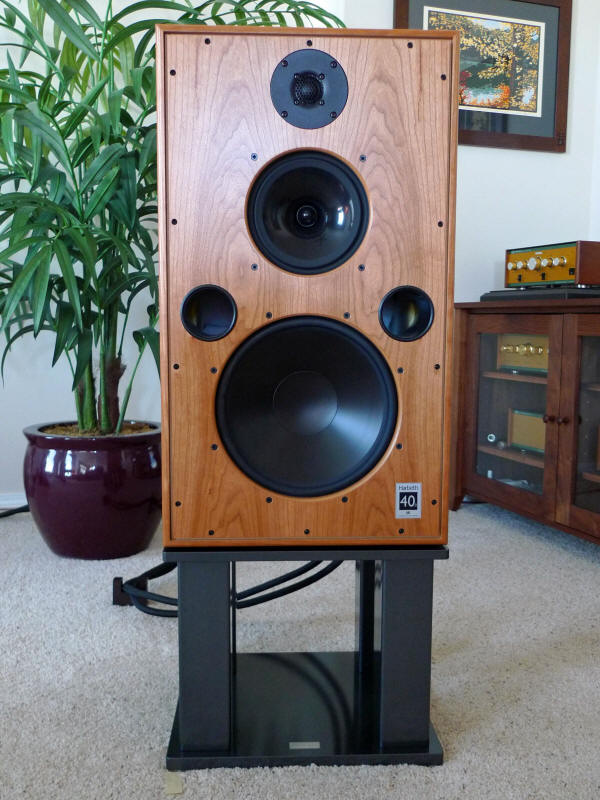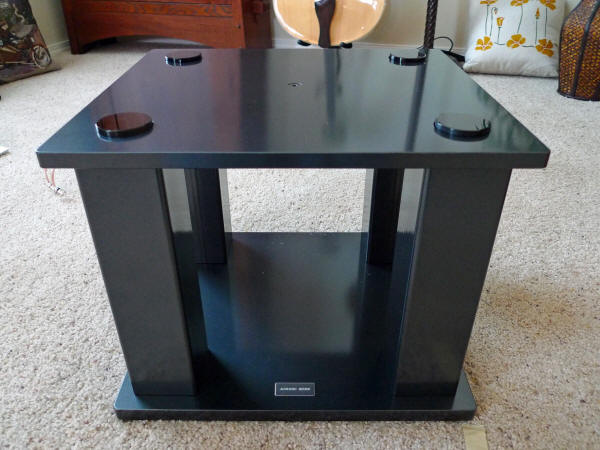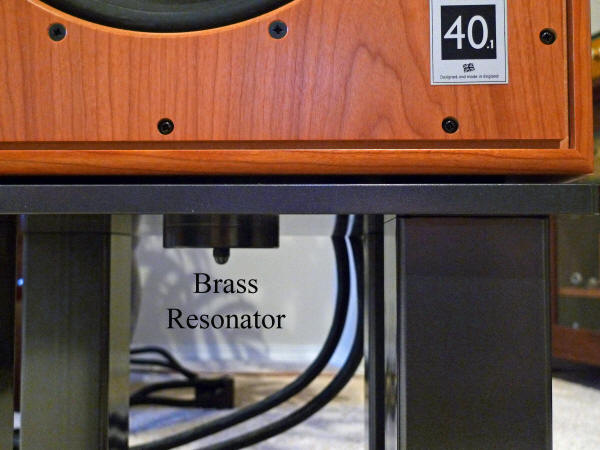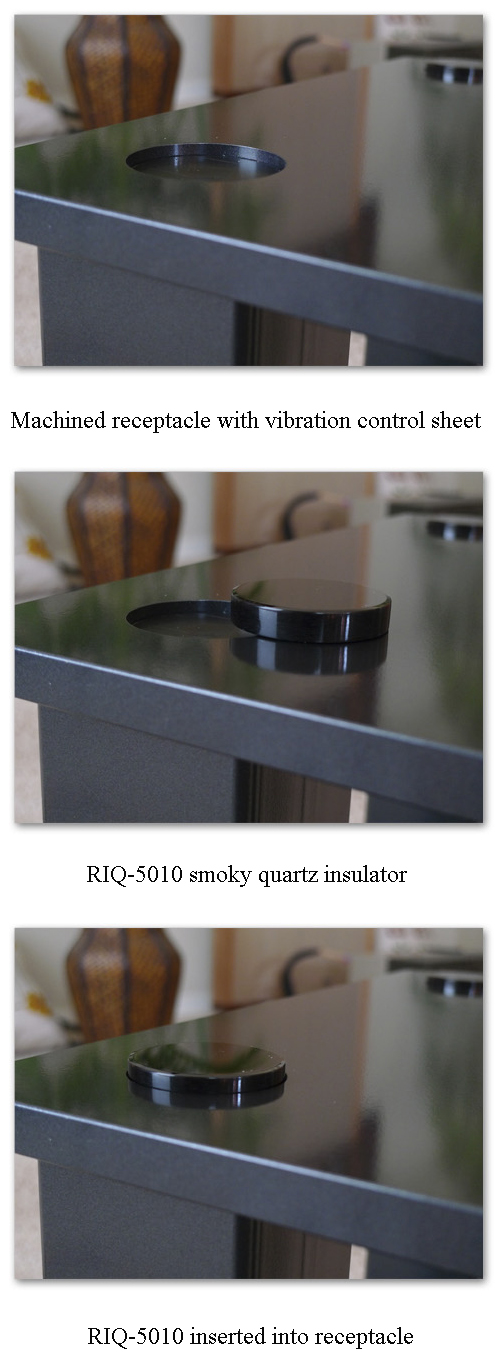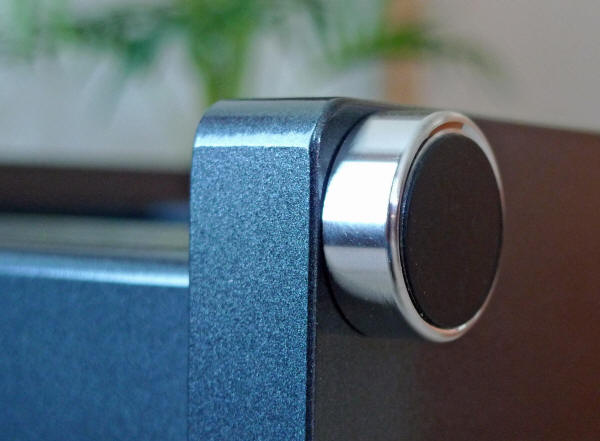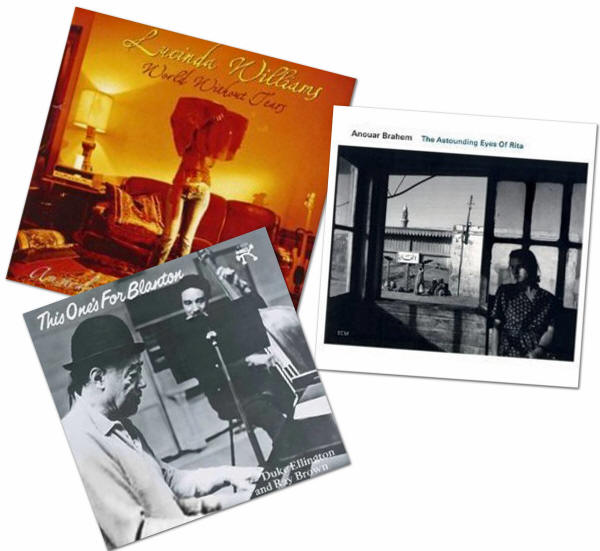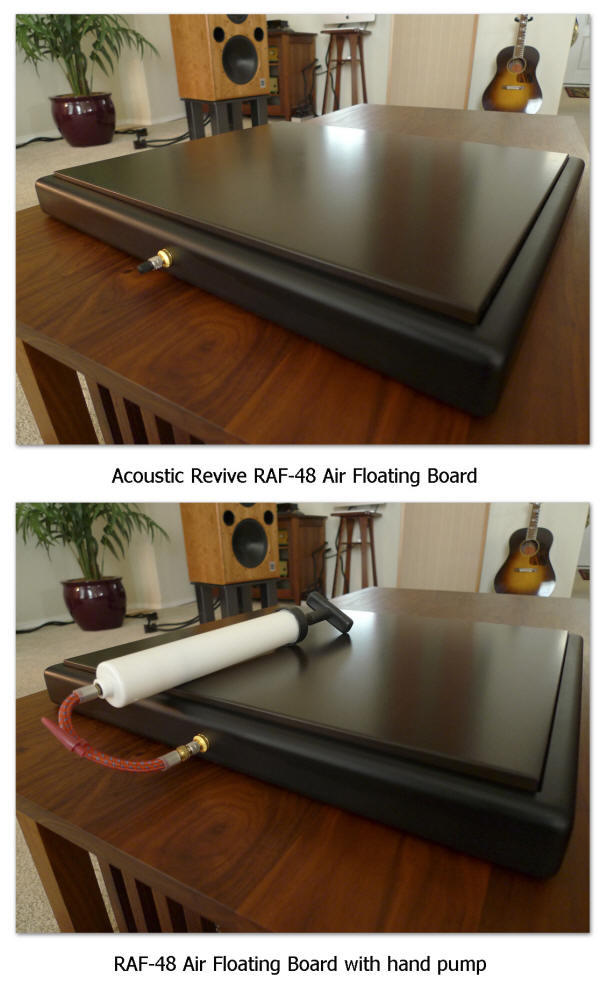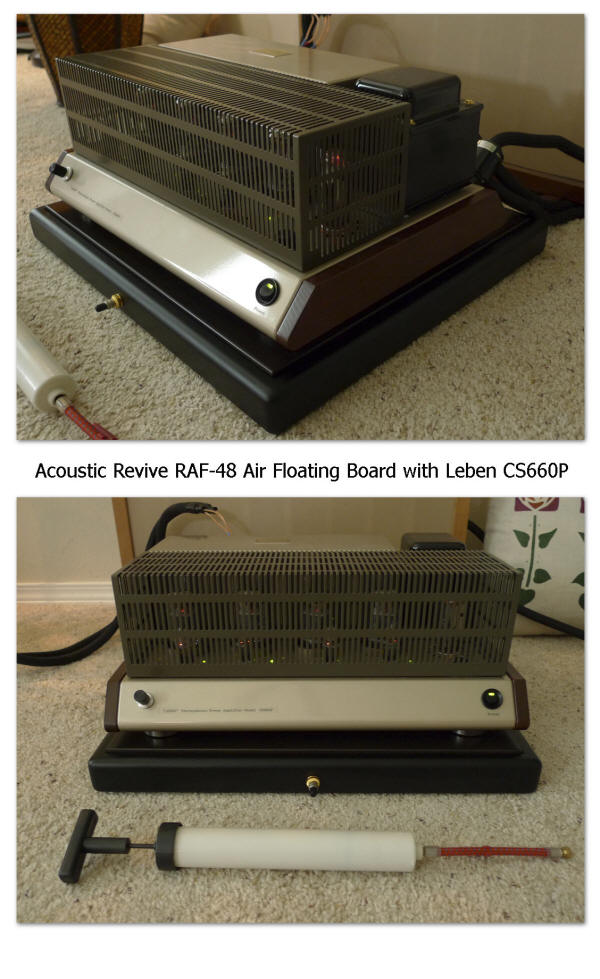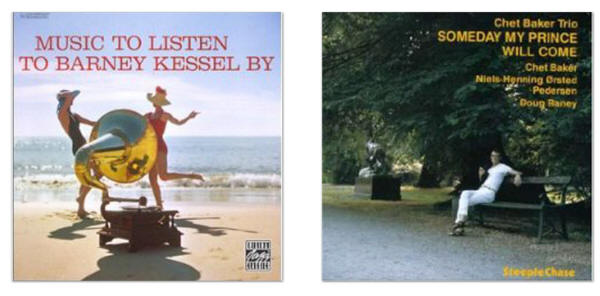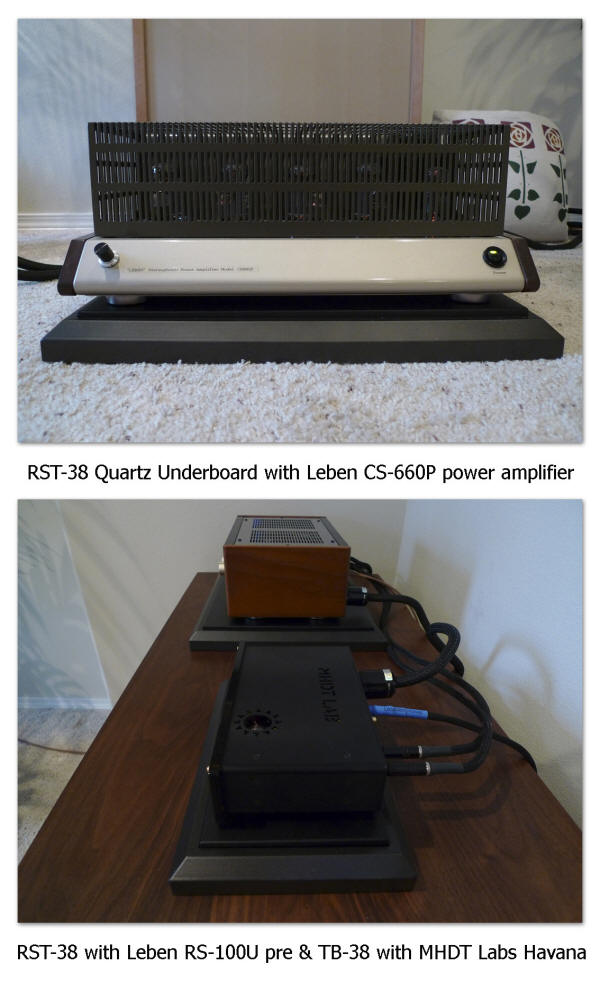|
You are reading the older HTML site Positive Feedback ISSUE 47january/february 2010
The
Acoustic Revive Chronicles, Chapter 7
A Standing Ovation: The Acoustic Revive Custom Series Loudspeaker Stands, the RST-38 and TB-38 Quartz Under-Boards, and the RAF-48 Air Floating Board I always get excited when I hear that there are Acoustic Revive products coming my way for review, because Mr. Ken Ishiguro's innovative applications of physics, materials science, and audio engineering principles to his product line of high-performance audio products never fails to amaze me in their effectiveness in enhancing the performance of my audio system. If you are new to the Acoustic Revive Chronicles you can catch past chapters here: Chapter 1, Chapter 2, Chapter 3, Chapter 4, Chapter 5, and Chapter 6, as well as coverage of the Acoustic Revive RIO-5II Negative Ion Generator and RD-3 Disc Demagnetizer at Positive Feedback Online here. I subtitled Chapter 7 of the Acoustic Revive Chronicles as "A Standing Ovation", which is a play on words, referring to the particularly innovative line of speaker and equipment stands developed by Mr. Ken Ishiguro, all of which are designed to maximize performance of audio gear by channeling and dissipating the deleterious effect of vibrational energy: the Custom Series loudspeaker stands, the RST-38 and TB-38 Quartz Under-Boards, and the RAF-48 Air Floating Board. Acoustic Revive Custom Series Loudspeaker Stands The performance enhancing ability of quality loudspeaker stands are often overlooked by Hi-Fi enthusiasts and loudspeaker manufacturers alike, who erroneously assume that a stand is just a stand, and does no more than position the loudspeaker at the correct height for listening. I have found that perspective to be rather naive, and the truth is that all of the stands I have owned have varied quite widely in their absolute performance level and acoustic signature.
The Acoustic Revive Custom Series of loudspeaker stands are a special order only item that are part of a custom service option that Acoustic Revive offers its customers, and as such are completely hand made and optimized for a particular loudspeaker and listener, and are intended to be quite literally the best loudspeaker stands in the world both in their quality of construction and in their contribution to audio performance. Like all Acoustic Revive products the Custom Series of loudspeaker stands are innovative in design, have a stunning level of quality of construction, and have an impeccable fit and finish. I have found the performance of the Custom Series loudspeaker stands to be absolutely stunning in my Hi-Fi system, and I think that they completely rewrite the book about what you can expect from the contribution of loudspeaker stands to audio performance. Much in the same way the introduction of state-of-art loudspeaker cables that dramatically outperformed the commonly used zip-cord wire of the day created a new component category, the Acoustic Revive Custom Series loudspeaker stands outperform typical loudspeaker stands creating an entirely new category of component: the ultra-performance loudspeaker stand.
Acoustic Revive says, "The purpose of a speaker stand is to bring out the full tone and performance of the speaker without altering its intrinsic sound or adding any coloration. Allowing the sound of the stand material to be heard, or robbing the speaker of necessary vibrations is not the way to create a genuine high quality speaker stand." To achieve that end Acoustic Revive has incorporated some very innovative features into the Custom stands that prevents vibrational energy from coming up from the floor through the stands to the loudspeakers, while still allowing the Harbeth M40.1 cabinets to resonate freely to dissipate energy as their designer Alan Shaw intended.
The top plate of the Custom stand is of 2017S Duralumin, with a brass resonator attached to its underside to rapidly dissipate vibrational energy. At each corner of the top plate a receptacle is machined into the surface to accept an Acoustic Revive RIQ-5010 smoky quartz isolator, which the loudspeaker rests on. To further improve vibrational control, a thin vibration control sheet is placed inside the receptacle that the quartz insulator disk sits on. The vibrational control sheet consists of a polymeric material developed by Professor Masao Sumita at the Tokyo Institute of Technology, the development of which was funded by the Japan Science and Technology Agency. The sheet material was developed to transfer and eliminate vibrational energy by turning it into electrical energy that is dissipated as heat.
The Custom stands' four columns are made from steel and are filled with a mixture of the piezoelectric mineral tourmaline and polypropylene particles to dissipate vibrational energy. The bottom plate of the Custom stand is made from the 2017S Duralumin aluminum alloy and can be fitted with stainless steel spikes or stainless steel feet (the feet have a layer of the above mentioned vibration control sheet applied to their bottoms). The review stands were impeccably finished in very attractive dark grey metallic gloss paint whose beauty the photos do not do justice.
The Custom series of stands are designed to route vibrational energy away from the loudspeakers as quickly as possible and dissipate it. Acoustic Revive does this by designing a directional path into the stands where vibrational energy is transferred to a harder material each time as it moves through the stands. Acoustic Revive says this has the effect of moving the vibration quickly through the stand and dissipating it via the mixture of the piezoelectric mineral tourmaline and polypropylene particles, which also minimize any vibrational feedback back up through the stand into the loudspeaker. Acoustic Revive eliminates the path of vibrational feedback from the stand into the body of the speaker by means of the quartz isolators sitting atop the vibrational control sheets in the receptacles in the top plate of the stands. Acoustic Revive says the combination of 2017S Duralumin, brass, steel, quartz, tourmaline, and vibration control materials in their Custom Series stands eliminates colorations induced by vibrational energy reaching the loudspeakers, and in so doing allows the speakers to exhibit the maximum clarity and tone they are capable of. Listening Impressions The first impressions I had of the Acoustic Revive Custom Series stands upon putting them under my Harbeth Monitor 40.1 loudspeakers were the dramatic increase of ease, liquidity, and utterly natural musical flow that they brought to the overall musical presentation, as well as being much more even sounding top to bottom, than the Skylan SKY-M40.1 stands that I normally use, which are an excellent value ($575 CAN) in loudspeaker stands made by cool uber guy Noel Nolan in Calgary. The high frequencies of the Harbeth Monitor 40.1s with the Custom Series stands were more extended, clean, airy, spacious, sweet, and never ever had even the slightest bit of edge—just completely and utterly acoustically natural. However, it was in the low frequencies where the Custom stands really blew me away with their taut and natural integration of the bass frequencies. I had been getting a distracting overemphasis in the bass of my M40.1s that required equalization to bring it in line with the mids and highs. Alan Shaw the Harbeth designer, and Walter Swanbon the North American Harbeth importer, were very helpful in trying to get the bass sorted out for me with the M40.1s (thanks guys), and had concluded that my room was the likely culprit and would require extensive acoustic treatment to correct. I figured it was the Harbeths' anechoically flat response that was responsible for the bass boost I was getting in my 'real-room' listening given I hadn't had any issues with other full-range loudspeakers. However, it turned out that we were all wrong and the room and Harbeths were fine, as the bass emphasis I was experiencing with the M40.1s completely disappeared with the Acoustic Revive Custom Series stands in place—the difference was profound, and a pleasant discovery.
Take for example Duke Ellington's Fragmented Suite for Piano and Bass from This Ones for Blanton, where Ray Brown's bass playing was utterly otherworldly, with every bit of tactile nuance and pitch differences coming through in his playing that was so impressive it gave me a case of 'chicken skin' that you couldn't pound down with a meat mallet. Pop music like Lucinda Williams' World Without Tears album, which I really enjoy listening to, but which I had thought had hopelessly overblown bass, turned out to be just fine with the M40.1s sitting atop the Acoustic Revive Custom Series stands, delivering clean, tight, deep, and powerful bass that was perfectly matched to the rest of the frequency spectrum. In comparison the Skylan stands, which by any normal measure are quite good, sounded boomy and unresolved in the bass compared to the Customs. Not only that, but I realized I had previously no idea how good the bass of the M40.1s could be, delivering clean, tight, powerful, deep bass punches that took my breath away, like Mike Tyson throwing a body combination at the top of his form. Yea, I'm impressed. With the Customs in place under the Harbeths the spaciousness of recordings opened way up, with the recorded acoustic filling up my living room from wall-to-wall, floor to ceiling. Take Anouar Brahem's album The Astounding Eyes of Rita as an example, where it is already a superbly spacious recording with a beautifully natural sounding recorded acoustic, and yet the Customs allow the space to unfold and fill my living room with an unparalleled sense of billowing space and recorded acoustic—truly impressive performance. In know it's cliché, but with the Acoustic Revive Custom Series stands in place under the Harbeths, I was hearing all kinds of new details and musical nuance in familiar recordings that I'd never ever heard before, making for a real spell-binding and thrilling musical performance as I waited for the music to unfold and reveal its new secrets to me. There was a considerable increase in resolution of detail, articulation, and clarity, but with no etched and edgy downside that normally comes with those sorts of increases, and if anything, everything sounded more tonally natural and colorful with a luxurious sense of ease that you just have to hear to fully appreciate. Performance parameters like imaging and soundstaging increased as well, with images taking on solidity and highlighted presence akin to what you get with the very best directly heated SET amplifiers. I suppose I could rave on and on, about the Customs ability to let all of the tone color of the Harbeth Monitor 40.1s come through, or the way they free notes up to decay in an utterly realistic and sensual fashion, but suffice it to say the Acoustic Revive Custom Series loudspeaker stands under my Harbeth Monitor 40.1 loudspeakers were a rather astounding revelation as to what is possible in the realm of loudspeaker stands. The Acoustic Revive Custom Series stands are freaky good and reveal clearly what truly grand musical instruments Alan Shaw's new Harbeth Monitor 40.1 loudspeakers are—I knew they were good, but I didn't know they were this good. If you have M40.1s you haven't heard them until you've heard them on the Acoustic Revive Custom Series loudspeaker stands. The Acoustic Revive Custom Series loudspeaker stands are a precedent setting product that elevates loudspeaker stands to a component-like status rather than being just something to sit loudspeakers upon. As a side note, I didn't find out how much the Acoustic Revive Custom Series stands cost until I was almost finished writing this article, and when I did I was almost speechless that the stands at $10,495 USD cost nearly as much as my Harbeth Monitor 40.1 loudspeakers at $12,995 USD. Rather unfortunately the Custom's price places them in a rarefied territory where relatively few people will be able to experience them. The price mentioned above is specifically for the custom stands created for the Harbeth Monitor 40.1 loudspeakers used in this article, and the price quoted to you for Custom Series loudspeaker stands may be more or less depending on your particular loudspeakers and any special features you may want to include. The Acoustic Revive Custom Series loudspeaker stands for the Harbeth Monitor 40.1 offer truly impressive performance, but at a price so high that it makes your teeth hurt, so they are for those few enthusiasts for whom cost is not a factor at all, and it is to them that I give the Customs the highest possible recommendation. But there is hope: In talking with Mr. Yoshi Hontani, the Acoustic Revive exporter in Japan, he relayed a message to me from Mr. Ken Ishiguro that the Acoustic Revive RSS-600 production speaker stands have many of the same design features incorporated into them as the Custom Series Harbeth Monitor 40.1 loudspeaker stands that I've written about in this article, and that they come quite close to them in performance, but at a more accessible price of $4250 USD. That's still a lot of money for most people in this day and age of faltering economies, but it is a price that's within reach of quite a few enthusiasts putting together a top-notch Hi-Fi system based on the Harbeth Monitor 40.1 (or other high-performance loudspeakers).
Acoustic Revive RAF-48 Air Floating Board Isolation Platform The Acoustic Revive RAF-48 Air Floating Board is an isolation platform similar in concept to the air isolation tables used to isolate scanning electron microscopes from the vibration that decreases their image resolution, and which are something I see quite frequently during the day job. The RAF-48 cabinet measures 19 x 17.25 inches, its top plate measures 17.5 x 15.5 inches, it is less than 2 inches high, and it is rated to accept components up to a maximum weight of 132 pounds (60 Kg), which means my large and heavy Leben CS-660P power amplifier fits on it like it was made to order. The cabinet and top board are constructed of Finnish birch. The RAF-48 has an internal air bladder that is filled by means of a small hand pump through a valve stem located at the front of the chassis. Acoustic Revive says that you can expect an improved signal-to-noise ratio, greater transparency and texture, and a wider, deeper, and higher soundstage when using an RAF-48 under your components. One thing that I did find with the RAF-48 is that when using it with heavier components like the Leben CS-660P you will need to pump up the air chamber before each listening session to ensure that it is at the proper pressure for optimum isolation.
Listening Impressions My Leben CS-660P power amplifier sitting upon the Acoustic Revive RAF-48 Air Floating Board isolation platform had much the same sort of effect on the overall sound of my Hi-Fi rig as sitting my Harbeth Monitor 40.1 loudspeakers upon the Acoustic Revive Custom Series loudspeaker stands did, albeit to a lesser extent, but a significant effect that was still immediately obvious. For example, on Barney Kessel's Indian Summer from the Music to Listen to Barney Kessel By album, everything became more natural and less electronic sounding, more melodically tuneful, more liquid, with instruments taking on a captivating relaxed clarity, while becoming more timbrally natural and infused with deeper tonal color. Like the Custom Series stands, the Revive RAF-48 Air Floating Board also improved the bass balance and articulation in my system, which was readily apparent, for example, on Chet Baker's Gnid from his Someday My Price Will Come album, while also creating a greater sense of space, and a stronger infusion into the listening room of the recorded acoustic. What can I say—the Acoustic Revive RAF-48 Air Floating Board isolation platform, like the Custom stands, is another home run by Mr. Ken Ishiguro.
Acoustic Revive RST-38 and TB-38 Quartz Under-Boards The Acoustic Revive RST-38 and TB-38 Under-Boards are stands, or more correctly, vibrational energy dissipation platforms, to place your audio equipment upon, and are offered as alternatives to the more expensive RAF-48 Air Floating Board. The RST-38 and TB-38 Under-Boards are designed to quickly route vibrational energy away from audio components and dissipate it. They feature a composite wood chassis that is filled with quartz granules, upon which a birch plywood top plate is placed to sit components upon.
The idea behind using quartz fill in the chassis of the RST-38 and TB-38 Under-Boards is to harness the piezoelectric properties of quartz to dissipate vibrational energy, thereby improving the sound of HiFi electronics placed upon them. Acoustic Revive says that vibrational energy from a component travels through the top board to the quartz filling where it is dissipated, and conversely that vibrational energy coming up through the floor or equipment into the Under-Board's chassis is also transferred to the quartz and dissipated.
The base of the RST-38 measures 19 x 15 inches, its top plate 17 x 13 inches, and with a load carrying capacity of 100Kg that means even large and heavy audio electronics like power amplifiers can be placed upon it, and my Leben CS660P or Leben RS-100U. The base of the TB-38 measures 13.5 x 8.5 inches, its top plate 11.75 x 6.75 inches, and is suitable for smaller components like my Mhdt Labs Havana USB DAC or Acoustic Revive RPT-4 Ultimate power supply box. Listening Impressions I'm starting to feel a little like a skipping and repeating record, as I have to say that my Hi-Fi components sitting the Acoustic Revive RST-38 and TB-38 Under-Boards exhibited the same sorts of improvements to my overall system sound as did the Acoustic Revive Custom Series loudspeaker stands or RAF-48 Air Floating Board isolation platform did. The difference between the RST-38 and TB-38 Under-Boards and the RAF-48 Air Floating Board is in the magnitude of improvement, where with the latter the isolation effect was greater. All of these vibration isolation devices have had much the same sort of effect on the overall sound of my Hi-Fi rig, with transparency increasing, but with the music becoming more natural and less electronic sounding at the same time. Well, what can I say? Everything gets better; you get better sonic performance and better musical performance at the same time—they're a no-downside addition to your Hi-Fi rig for sure. One thing that I do like about the RST-38 and TB-38 Under-Boards is that you don't have to pump them up like you do the RAF-48 Air Floating Board. Once you set them up and place your components on them you can forget about them, which is a nice touch. Summary and Conclusions This is my first experience with devices that reduce the degradation of loudspeaker and electronics performance via vibration isolation and dissipation, and I have to say it was a real eye-opener, particularly when everything in my system was isolated including power supply boxes, sources, amplification, and loudspeakers. There's a cumulative effect to isolation, and I have to say that if you haven't heard your system fully isolated from the deleterious effects of vibration you really have no idea what level of performance your system is capable of—it's that big of a deal. The difference rendered in my Harbeth Monitor 40.1 loudspeakers from the Acoustic Revive Custom Series loudspeaker stands was particularly shocking, and I am quite beside myself with the result. I suspect even Alan Shaw has no idea how good his new M40.1 loudspeakers can sound since he hasn't heard them on the Acoustic Revive Custom Series loudspeaker stands. I started with a reference to a 'standing ovation' as a play on words about speaker stands and isolation stands, but let me conclude with a literal standing ovation to Mr. Ken Ishiguro of Acoustic Revive, whose innovative applications of physics, materials science, and audio engineering principles to vibration control in audio products is truly remarkable. If you have a mature audio system that you want to take to the next level, and the price of these products doesn't represent a hardship for you, I can't imagine anyone not being thrilled with the increase in performance that results from them. Very highly recommended. Pricing: Acoustic Revive Custom Series Loudspeaker Stands ($10495 USD), Acoustic Revive RST-38 Quartz Under-Board Isolation Platform ($1100 USD), Acoustic Revive TB-38 Quartz Under-Board Isolation Platform ($725 USD), and the Acoustic Revive RAF-48 Air Floating Board Isolation Platform ($1850 USD). Quality of construction: Absolutely superb.
Acoustic Revive US Importer
The Lotus Group
|

